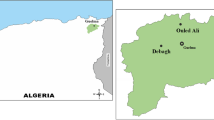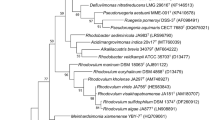Abstract
Here we describe a new, extremely thermophilic amoeba growing between 33 °C and 57 °C (T opt. = 50 °C). Isolates had been obtained from hot springs at Agnano Terme (Italy), Yellowstone National Park (USA), Kamchatka (Russia), and the Arenal Volcano (Costa Rica). They could be cultured monoxenically on a thermophilic alpha-proteobacterium. The morphology of the amoeba was studied using a microscope situated under a heatable polyacrylate hood. At 50 °C, the cells appeared flat with an irregular triangular or elongate shape, sometimes exhibiting fine spine-like subpseudopodia. On average, they were 22 μm long and 11 μm wide and had one nucleus with a central nucleolus. Based on morphology and on SSU rRNA comparisons, the amoeba belonged to the genus Echinamoeba, where it represents a new species. Referring to its extremely thermophilic lifestyle and its hydrothermal habitat, we name it E. thermarum.





Similar content being viewed by others
References
Amaral Zettler LA, Nerad TA, O'Kelly CJ, Peglar MT, Gillevet PM, Silberman JD, Sogin ML (2000) A molecular reassessment of the leptomyxid amoebae. Protist 151:275–282
Ashkin A, Dziedzic JM, Yamane T (1987) Optical trapping and manipulation of single cells using infrared laser beams. Nature 330:769–771
Baumgartner M, Stetter KO, Foissner W (2002) Morphological, small subunit rRNA, and physiological characterization of Trimyema minutum (Kahl, 1931), an anaerobic ciliate from submarine hydrothermal vents growing from 28 °C to 52 °C. J Eukaryot Microbiol 49:227–238
De Jonckheere JF (2002) A century of research on the amoeboflagellate genus Naegleria. Acta Protozool 41:309–342
Fields BS, Sanden GN, Barbaree JM, Morrill WE, Wadowsky RM, White EH, Feeley JC (1989) Intracellular multiplication of Legionella pneumophila in amoebae isolated from hospital hot water tanks. Curr Microbiol 18:131–137
Gunderson JH, Sogin ML, Wollett G, Hollingdale M, De La Cruz VF, Waters AP, McCutchan TF (1987) Structurally distinct, stage-specific ribosomes occur in Plasmodium. Science 238:933–937
Hindle E (1932) Some new thermophilic organisms. J R Microsc Soc 52:123–133
Holzmann M, Piller W, Pawlowski J (1996) Sequence variations in the large-subunit ribosomal RNA gene of Ammonia (Foraminifera, Protozoa) and their evolutionary implications. J Mol Evol 43:145–151
Horn C, Paulmann B, Kerlen G, Junker N, Huber H (1999) In vivo observation of cell division of anaerobic hyperthermophiles by using a high-intensity dark-field microscope. J Bacteriol 181:5114–5118
Huber R, Burggraf S, Mayer T, Barns SM, Rossnagel P, Stetter KO (1995) Isolation of a hyperthermophilic archaeum predicted by in situ RNA analysis. Nature 376:57–58
Kahan D (1969) The fauna of hot springs. Verh Internat Verein Limnol 17:811–816
Medlin L, Elwood HJ, Stickel S, Sogin LM (1988) The characterization of enzymatically amplified eukaryotic 16S-like rRNA-coding regions. Gene 71:491–499
Page FC (1967) Taxonomic criteria for limax amoebae, with descriptions of 3 new species of Hartmannella and 3 of Vahlkampfia. J Protozool 14:499–521
Page FC (1975) A new family of amoebae with fine pseudopodia. Zool J Linn Soc 56:73–89
Page FC (1988) A new key to freshwater and soil Gymnamoebae with instructions for culture. Freshwater Biological Association, Cumbria
Page FC, Siemensma FJ (1991) Nackte Rhizopoda und Heliozoa, Protozoenfauna, vol 2. Fischer, Stuttgart
Posada D, Crandall KA (1998) Modeltest: testing the model of DNA substitution. Bioinformatics 14:817–818
Ramaley RF, Scanlan PL, O'Dell WD (2001) Presence of thermophilic Naegleria isolates in the Yellowstone and Grand Teton National Parks. In: Reysenbach AL, Voytek M, Mancinelli R (eds) Thermophiles: biodiversity, ecology, and evolution. Kluwer Academic, New York, pp 41–50
Rohr U, Weber S, Michel R, Selenka F, Wilhelm M (1998) Comparison of free-living amoebae in hot water systems of hospitals with isolates from moist sanitary areas by identifying genera and determining temperature tolerance. Appl Environ Microbiol 64:1822–1824
Swofford DL (1999) PAUP*. Phylogenetic Analysis using Parsimony (*and other methods) Version 4. Sinauer, Sunderland
Tansey MR, Brock TD (1978) Microbial life at high temperatures: ecological aspects. In: Kushner DJ (ed) Microbial life in extreme environments. Academic, New York, pp 159–216
Wuyst J, De Rijk P, Van de Peer Y, Pison G, Rousseeuw P, De Wachter R (2000) Comparative analysis of more than 3000 sequences reveals the existence of two pseudoknots in area V4 of eukaryotic small subunit ribosomal RNA. Nucleic Acids Res 28:4698–4708
Xiao L, Limor JR, Li L, Morgan U, Thompson RCA, Lal AA (1999) Presence of heterogeneous copies of the small subunit rRNA gene in Crytosporidium parvum human and marsupial genotypes and Crytosporidium felis. J Eukaryot Microbiol 46:44S–45S
Acknowledgements
We are indebted to R. Michel for advice in the taxonomic classification of the amoebae and to L. Amaral Zettler for providing the alignment of SSU rRNA sequences. We further thank C. Petzel for excellent technical assistance and R. Rachel for helpful discussions. This work was supported by the Deutsche Forschungsgemeinschaft (SFB 521), the Deutscher Akademischer Austausch Dienst (scholarship to A.Y.), and the Fonds der Chemischen Industrie (K.O.S.).
Author information
Authors and Affiliations
Corresponding author
Additional information
Communicated by K. Horikoshi
Rights and permissions
About this article
Cite this article
Baumgartner, M., Yapi, A., Gröbner-Ferreira, R. et al. Cultivation and properties of Echinamoeba thermarum n. sp., an extremely thermophilic amoeba thriving in hot springs. Extremophiles 7, 267–274 (2003). https://doi.org/10.1007/s00792-003-0319-6
Received:
Accepted:
Published:
Issue Date:
DOI: https://doi.org/10.1007/s00792-003-0319-6




